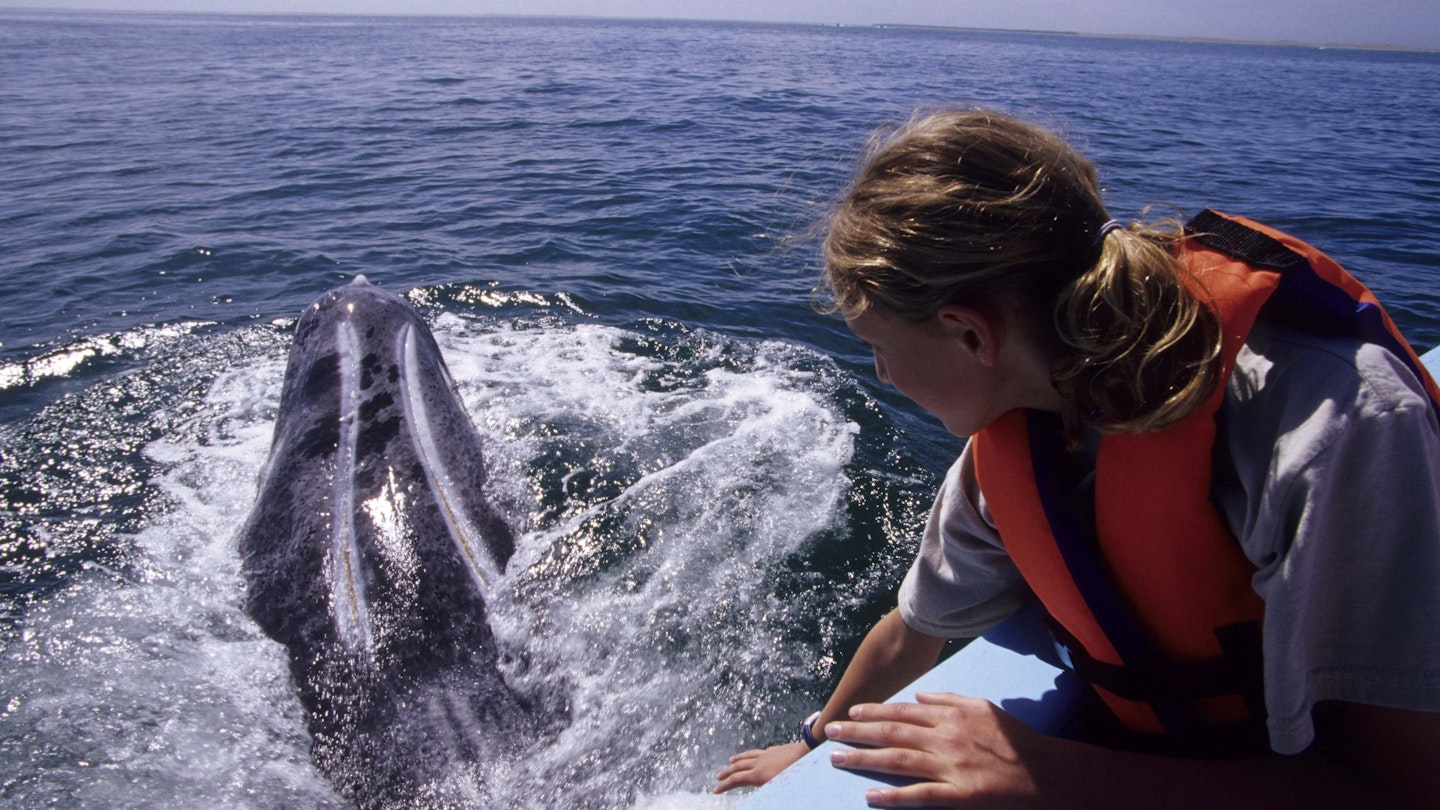Setting off from a dock in la Bahía de La Paz, the capital of Baja California Sur, the boat slows as the first whale shark of the day comes into view. Before picking up speed again, the true rarity appears: a humpback whale. ‘Welcome to the Sea of Cortez,’ said Javier Olachea, a wildlife guide with 25 years of experience for The Cortez Club, an eco-tour operator.
Baja California Sur is one of the last remaining destinations for close encounters with oceanic wildlife, as well as one of the easiest points of access to these magnificent creatures. The Mexican government and adventure travel operators are acting to preserve the animals that live within the Sea of Cortez. Marine biologists engage in research and conservation efforts, and to learn from unchecked travel destinations, scientists are actively participating in the tourism industry of this ecologically fragile peninsula.
Protecting Ocean Wildlife
Nonprofits and organizations such as the Whale Shark Research Project and Tortugueros Las Playitas aim to conserve and educate about the impact of climate change on wildlife. Regional biologists hope to inspire travelers to care for preserving these species through their research and interactions with intelligent marine animals.
In addition to research, Mexico’s government has enacted restrictions to prevent over-tourism. For instance, Isla Espiritu Santo and the waters where whale sharks feed near el mogote—a protective sand barrier to La Paz—are safeguarded under CONANP, The National Commission of Natural Protected Areas, along with PROFEPA, The Federal Attorney for Environmental Protection. To ensure the safety of marine life, agency guidelines specify the number of boats permitted in the area, the number of people allowed in the water, and the length of time guests can linger.
Tour operators charge a ‘permission to enter fee’ required by both organizations. These funds help maintain and protect the habitat and animals while enabling the ongoing surveillance and preservation of the area. A portion of the fees, coupled with a government grant, helps lessen the pressure to generate income from fines.

How to Sustainably Experience Wild Animals
The Sea of Cortez is renowned by divers worldwide as ‘the world’s largest aquarium,’ thanks to Jacques Cousteau. Close encounters are best experienced in the water—whether diving or snorkeling alongside the marine life; however, environmentally-conscious travelers can learn about the animals through considerable educational resources like the Whale Museum in La Paz or by participating in research expeditions.
As adventure and environmental tourism grow, verifying the reputation of a tour operator becomes crucial. An influx of tourists near wildlife habitats and the use of improper practices by some tour operators can have detrimental effects. Intimidated animals may be forced to relocate, deplete their feeding grounds, or their habitats may suffer destruction. Nevertheless, travelers can implement measures to ensure their experiences are sustainable.
It is beneficial to check the website of the destination’s government tourism board. Many sites provide a list of endorsed tours and operators which signifies compliance with best practices. For instance, Go La Paz and Loreto highlight credible companies that have successfully completed an annual PROFEPA certification class and test.
PROFEPA also offers searchable press releases to inform the public of the latest infractions and relevant news.

Where and When to View Sea Life
La Paz
Sea turtles, manta rays, and dolphins movement through the bay of La Paz. According to Olachea, even orca whales occasionally navigate these waters. Visitors can learn about vaquitas—tiny porpoises that are on the brink of extinction—alongside efforts to rescue these delicate animals at the Whale Museum.
While the Sea of Cortez houses 35 percent of the world’s marine mammals, two species particularly garner interest: sea lions and whale sharks. Both are classified as endangered; however, whale sharks face greater threats within the Sea of Cortez. Located 36 kilometers from the city, colonies of sea lions have claimed the cliffs and caves of Isla Espiritu Santo, which provide natural refuge from potential overpopulation.
Adolescent whale sharks, which typically measure between five and eight meters, remain close to shore to feed and grow. To ensure the safety and well-being of these animals, tour boat captains must radio in to obtain permission before entering the whale sharks’ feeding grounds near el mogote.
Occasionally, a surprising sighting occurs while traveling to Isla Espiritu Santo at a rocky island. The blue-footed booby, which is rarely seen outside the Galápagos, can sometimes be spotted along the coast of Baja California Sur. To see all three types of these remarkable creatures, visit between October and March.
Magdalena Bay
Two hours north of La Paz, Magdalena Bay is home to approximately 400 gray whales. This bay, protected by Isla Santa Margarita and Isla Magdalena, offers a tranquil setting for these mammals. Returning annually to mate and give birth, winter months—specifically December, January, and February—are ideal for sightings. Eco-tour companies like La Choya, based in La Paz, employ knowledgeable marine biologists who can identify newborns, young calves, females, and males.
Loreto
Farther north in Loreto, travelers can encounter blue whales and humpback whales migrating between January and March. Larger than gray whales, humpbacks thrive in the fertile feeding grounds off Loreto’s coast. These vast waters also attract the largest animals on the planet, blue whales, providing ample space for swimming, feeding, and mating.

Tips for When You Go
It is advisable to visit in February, a prime month when many exciting marine species surface. International flights go to Los Cabos or domestic flights to La Paz are available, and airport transfers can often be coordinated with tour operators. For those arriving by boat, resorts like Costa Baja Resort & Spa feature a marina on-site.
To contribute to ongoing conservation efforts in La Paz, there are various options for participating in structured adventures. Engage with The Cortez Club for an adventurous swim with marine life. Baja Expeditions provides multi-day trips featuring alternative activities such as kayaking and camping on Isla Espiritu Santo. For the scientifically-minded, Red Travel Mexico offers opportunities to assist with marine research.





